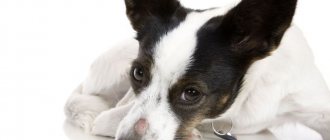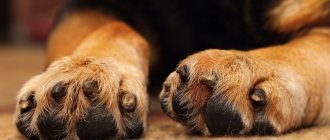Why do animals twitch in their sleep?
Your dog isn't the only one who twitches in his sleep. As it turns out, almost all animal scientists have studied this phenomenon, known as myoclonic jerks.
Puppies and other young animals are especially fussy when they sleep. Some scientists suggest that this has something to do with early development. These twitches could, on a simplistic level, be the body's way of figuring out "what is this limb and what should I do with it?"
This is just a theory at this point, but the more we learn about sleep in animals and humans, the more answers we will have about the role of sleep and myoclonic jerks in our development.
Just like puppies, older dogs twitch more than middle-aged dogs. One proposed theory that may explain this is that the part of a dog's brain that paralyzes large muscles during sleep (preventing your dog from actually jumping up to chase the dream squirrel) is underdeveloped in puppies and less effective in older dogs.
Regardless of the reasoning, even middle-aged dogs twitch, which means there's definitely something going on in your dog's head when he's sleeping.
Your dog is not alone in this. You may have noticed that you or your loved ones twitch in their sleep, sometimes leading to accidental elbows or kicks.
These twitches are believed to be associated with dreams.
What do animals dream about?
So far no one has been able to “spy” on the dreams of animals. However, scientists have reason to believe that they are more diverse than we might imagine. Definitely, often a dream is a reflection of what has been experienced. Therefore, the central part of the plot is usually the owner, who is the center of the universe for the dog. Often dogs in which the “blue spot” was neutralized, in the active phase of sleep, did everything the same as during the day: played, followed commands, ran.
However, studies have shown that it is during sleep that ancient instincts manifest themselves in animals. Thus, even trained dogs, whose ancestors served humans for many generations, can begin to howl like wolves during the deep phase. And under the influence of drugs, they completely demonstrated original behavior: even decorative dogs could “go hunting” and demonstrate behavior characteristic of their ancestors in the pack.
Do dogs dream?
Since we can't exactly ask our dogs if they can dream, and if so, what they dream about, science has come up with some interesting ways to determine whether dogs and other animals dream.
A 2001 study from the Massachusetts Institute of Technology (MIT) found that laboratory rats trained to run through a maze exhibited brain activity during rapid eye movement (REM) sleep similar to that when they were actually in the maze, resulting in researchers concluded that the rats were dreaming about the maze they had run into earlier.
In fact, their data was so specific that they could determine where in the maze the rat was daydreaming itself just by looking at the rat's unique signature of brain activity.
Since rats are less complex than dogs, it's safe to conclude that our dogs dream too.
We can't know exactly what dogs dream about because scientists haven't studied them as closely as they have studied rats, but researchers have noticed that certain breeds of dogs tend to engage in breed-specific behavior while sleeping. For example, Pointers, Pointers, and English Springer Spaniels exhibit blushing during REM sleep.
How do dogs' dreams differ from human dreams?
With the advent of technology that allows one to monitor brain activity during sleep, experiments on dogs were continued. With their help, it was possible to prove that dog dreams are different from human dreams. They are brighter, more dynamic, and quickly replace each other. Thus, the deep sleep phase in a person can last about one and a half hours. During this time, he manages to view the whole story. In dogs, it takes on average 20-25 minutes, and the dream consists of 2-3 pictures that quickly replace each other.
Interesting! In small breeds of dogs, sleep phases alternate more often than in adults. So, in a toy terrier this can happen every 10 minutes, in a Great Dane - every hour.
Scientists are also inclined to believe that during sleep, animals can not only see and hear, but also smell. This is evidenced by the fact that they often twitch their nose in their sleep, as if sniffing at something.
In small breeds of dogs, sleep phases alternate more often than in adults
Should you wake your dog if he is having a nightmare?
Daydreaming about a pleasant activity like chasing a ball or hunting is one thing, but what about those times when your dog seems anxious while sleeping?
Those whimpers, tiny howls and barks touch our heartstrings, and many owners are tempted to wake their dogs up as if they were dreaming of a baby.
This may not be the best idea. Disrupting your dog's REM sleep, which is the sleep cycle in which most dreaming occurs, can have serious consequences.
If you've ever woken up in the middle of a bad dream, then you know that it can take a few seconds for your brain to realize that you're awake and that there isn't a monster breathing down your neck.
Like us, dogs need time to adjust, but unlike us, waking up in the middle of a nightmare can result in an unintentional bite. This is dangerous for everyone in your family, so be sure to explain to children or guests that it is not safe to wake a sleeping dog.
At the very least, disrupting your dog's sleep can make him sleepy, which can be a problem for service dogs or dogs that participate in shows and sports.
The best thing you can do for a dog experiencing a nightmare is to calm him down when he wakes up.
Talk to your veterinarian if you suspect your dog is having seizures while sleeping rather than while sleeping. Seizures can have many causes, from epilepsy to cancer, and it is in your dog's best interest to be seen immediately to try to diagnose the cause.
Do dogs have nightmares?
Fears are often reflected in dreams, including those of dogs. It is not difficult to understand that a dog is seeing a “bad” dream. In this case, the pet will whine, tuck its tail, desperately pound its paws and demonstrate anxiety in all sorts of other ways.
If such cases are isolated, you may not attach much importance to this. However, after severe stress, nightmares may recur. This is a signal to the owner that the animal feels insecure, and can subsequently result in health problems.
You can calm the animal by following simple rules:
Fears are often reflected in dog dreams
Dreams of puppies
Research has also shown that dogs have their first dreams while still in the womb. Therefore, it is not surprising that newborns can squeak and move in their sleep.
Dogs begin to have their first dreams while still in the womb
Puppy dreams last longer than in adult dogs. The active phase can take up to 90% of their sleep time. In addition, the children’s nervous system has not strengthened, so they may react more violently to dreams. They often begin to bark and whine, thereby waking themselves up.
In cases of such an “emergency” awakening, they may behave inappropriately for a few seconds: look around, not understanding where they are, continue whining, or even jump up sharply and run.
Interesting! Puppies can sleep with their eyes open. In this case, the pupils are covered with a thin film - the third eyelid.
This behavior worsens when moving to a new home. This is a lot of stress for the puppy, so the owner will have to show maximum understanding and patience while waiting for the puppy to adapt. Once this happens, his sleep will become more restful.
When to worry
In some cases, movements during sleep indicate health problems. The owner should be wary of:
- trembling of the head, in the paws or in the whole body at once;
- convulsions;
- active strong pushes with paws;
- lethargy immediately after waking up.
Movement during sleep may indicate health problems
These signs may indicate serious health problems. It is worth taking a close look at your pet while he is awake to understand whether there is a need to contact a veterinarian. The following table will help you recognize the signs of the disease.
| Disease | Behavior during sleep | Other signs |
| Central nervous system disorders | Strong paw kicks, lethargy after waking up | Loss of coordination, lethargy |
| Hypothermia | Trembling, in some cases convulsions | Lethargy, tired appearance, fever |
| Heatstroke | Shiver | Lethargy, apathy, refusal to eat, fever |
| Viral diseases | Trembling, or in severe cases convulsions | Fever, thirst, lethargy |
| Poisoning | Convulsions | Lack of appetite, lethargy |
| Heart problems | Trembling, convulsions | Increased or slow heart rate |
If a dog actively moves its paws in its sleep, whines, or even growls, but behaves completely normally when awake, there is no need to worry. In her dreams, she experiences a whole storm of emotions that she cannot hide. So you can just watch your funny pet without interfering with his rest.
In his dreams, a dog can experience a whole storm of emotions
Anyone, even an inexperienced dog owner, has encountered the fact that a dog can lead a completely active life while sleeping. The pet can twitch its limbs (sometimes quite actively), shudder, whine, wiggle its ears, grin and even howl. Actually, there is a justified explanation for this behavior that will reassure the alarmed owners. However, there are a number of situations when a dog twitches in its sleep due to pathological conditions, and here a lot of excitement arises - the dog may need emergency medical care. How not to miss the first alarm bells and not to confuse your pet’s usual behavior with symptoms of illness?
When there is no reason to worry
If your small pet twitches and whines during the day or night, then there is no need to worry. It is also normal if a sleeping puppy's eyes do not close completely. In this case, you can examine the mucous membrane and understand that it is protected by a transparent film - this is the third eyelid.
If you watch a baby who has just woken up, you will notice how he tries to repeat what he saw in his dream. But even more often, the owners see a picture when a sleeping pet sharply moves its paws in its sleep, trying to escape. Usually the dog lies on its side, its legs begin to twitch, sometimes this process is accompanied by whining and even yelping. Some babies bark so loudly that they themselves wake up from their yapping, while being perplexed.
If your dog is active during sleep, it means he has entered the REM phase. When a dog wakes up on its own and was not woken up earlier, it will not remember what it saw in its dream. And if the dog was awakened by his own barking, he may jump up and continue what he was doing in the dream, and this is quite normal.
The younger the pet, the longer this phase is; in babies 8-16 weeks old, this period takes 9/10 of the total sleep time. Thanks to an experimental study, it turned out that dog babies experience their first dreams while still in the womb.











